As revealed by the 2023 Edelman Trust Barometer, Western societies are becoming increasingly polarised. The US is severely polarised and the UK, France and the Netherlands are in danger of severe polarisation. Canada, Australia and Ireland are on a path to polarisation.
Such social and political polarisation undermines our sense of mutual understanding, common values, common sense, shared identity and shared destiny. In other words, polarisation undermines common ground and our sense of a common good.
The causes of this division are many and complex. Nevertheless, certain trends seem clear. One of these is the division in people’s beliefs and corresponding ideological commitments about what constitutes a good and just society and how to achieve it.
An essentially contested concept
The Social Order and Social Justice framework
An intriguing new framework proposed by sociologists, John Iceland, Eric Silver, and Ilana Redstone provides fresh insights into these questions, helping to illuminate the nature of the polarisation within Western societies. Building on ideas from the psychological and social sciences, Iceland, Silver and Redstone delineate two basic worldviews, termed Social Justice and Social Order.
As described in their book, Why We Disagree about Inequality: Social Justice vs. Social Order, these worldviews are associated with a raft of different beliefs on everything from fairness and equality to the proper relationship between continuity and change.
Fairness and equality
Everyone is concerned with fairness. However, the worldviews have distinct conceptions of fairness. As described by Iceland and colleagues, the Social Justice perspective understands and measures fairness in terms of outcomes, whereas the Social Order perspective centres processes in how it understands and measures fairness.
Corresponding differences between the worldviews are observed in how equality is understood. The Social Justice perspective construes equality as equality of outcome and tends to interpret all disparities between people—specifically between groups—as the result of discrimination. By contrast, Social Order takes equality to mean equality of opportunity, with variation in outcomes between people attributable to individual differences in talent, effort, and preferences.
Choice and responsibility
Similarly, although everyone values freedom, the Social Justice and Social Order worldviews have distinct beliefs about what freedom means and how freedom is realised. Whereas a Social Justice perspective views freedom in terms of power and influence, freedom is understood in terms of options and opportunities from the Social Order viewpoint.
While both worldviews are concerned with people’s ability to make choices, they differ in how they think about a person’s ability, and responsibility, to do so. From the Social Order perspective, people should have the freedom to pursue opportunities for well-being and success. The Social Order worldview thus centres individual choice and responsibility. By contrast, the Social Justice perspective is more concerned with people’s freedom from discrimination and oppression.
Ethics and morality
As with fairness and freedom, care for others is universally valued. Drawing on moral foundations theory, which holds that our moral foundations coalesce around ‘individualising’ moral intuitions (i.e., putting the care of individuals at the centre of moral concern) and ‘binding’ moral intuitions (i.e., putting stability and group cohesion at the centre of moral concern), Iceland and colleagues propose that the worldviews have distinct moral foundations.
Specifically, Iceland and colleagues contend that the morality of people with a Social Justice worldview is based on individualising foundations that centre care for the vulnerable. By contrast, group loyalty and respect for authority is held to be central to the Social Order perspective.
Human nature and social change
Finally, while proponents of each worldview see room for improvement in existing social systems, they differ in their beliefs about the type of change that is needed and how it ought to be achieved.
The Social Justice perspective favours rapid, extensive change to reorder the world, believing in the perfectibility of people and social systems. This reflects what Thomas Sowell calls an “unconstrained vision” of human nature and society. By contrast, Social Order favours slow, incremental change, reflecting a more pessimistic “constrained vision” of human nature and society.
These perspectives are thus associated with different dispositions towards the past. The Social Justice worldview is associated with a posture of repudiation of tradition. It yearns to eliminate what are seen as outdated mindsets, practices and institutions. By contrast, the Social Order view is marked by an appreciation of the wisdom of the past, while recognising that there is room for improvement via incremental change that seeks remain alive to the trade-offs that attend progress.
Balancing Social Justice and Social Order

Some twenty years ago now, the writer and philosopher John Ralston Saul wrote On equilibrium. In it, he explored what he regarded as the essential qualities of humanity—common sense, ethics, imagination, intuition, memory, and reason—and how these qualities can be used to achieve equilibrium for the self and foster an ethical society.
Saul argued that when our qualities are worshipped in isolation, unbalanced by other qualities, they become forces of destruction. In short, Saul argued, they become ideologies. These insights are just as relevant to the relationship between the Social Justice and Social Order worldviews.
There is nothing especially new about this insight. For instance, it was observed by the nineteenth century philosopher John Stuart Mill in On Liberty:
“In politics…it is almost a commonplace, that a party of order or stability, and a party of progress and reform, are both necessary elements of a healthy state of political life…Each of these modes of thinking derives its utility from the deficiencies of the other…[It]…is a great measure the opposition of the other that keeps each within the limits of reason and sanity.”
This idea found expression more recently in the work of Marco Verweij and colleagues. Drawing on decades of social science research, these scholars contend that four social forms pattern social life – egalitarianism, hierarchy, individualism, and fatalism – all of which are natural, and co-existing, ways to perceive, organise, and justify social relations.
Despite their contradictions, these social forms exist in a fragile balance, requiring the moderating influence of all the others to stop them degenerating into self-limiting, destructive ideologies. As summarised by Schwartz:
“Each way of life undermines itself. Individualism would mean chaos without hierarchical authority to enforce contracts and repel enemies. To get work done and settle disputes the egalitarian order needs hierarchy. Hierarchies, in turn, would be stagnant without the creative energy of individualism, uncohesive without the binding force of equality, unstable without the passivity and acquiescence of fatalism. [These]…ways of life thus exist in alliance, yet this relationship is fragile, constantly shifting, constantly generating a societal environment conducive to change.”
Crucially, each time a perspective is excluded from collective sense-making and decision-making in shared-power contexts that typify life in pluralistic societies, governance failure often results. This is an important insight.
Precisely the same arguments could be made for the productive tensions that inhere between the Social Justice and Social Order worldviews.
Although these worldviews are in tension, each contains wisdom that is lacking in the other. Without this fragile balance, each perspective could devolve into ideology, harming the individuals and society it purports to help.
Similarly, as observed by John Stuart Mill, perspectives that value stability (Social Order) and reform (Social Justice) are vital for a healthy political life. Their co-existence tempers our natural desire for progress with an equally natural desire to protect the good things that have been passed to us by our forebears. In Saul’s terms, striking this balance might be understood as seeking equilibrium between imagination, common sense, and memory.
Ultimately, each worldview distils elements of experience and wisdom that is missed by the other. Each provides an expression of the way in which a large proportion of the populace feels we should live with one another. They are both part of the puzzle and paradox that is the common good.
Implications for leadership for the common good

What are the implications of these insights for institutional leadership for the common good?
As revealed by the Australian Leadership Index, people’s judgements about institutional integrity, competence and contribution play important roles in their assessment of institutional leadership for the common good. For example, emergency services, higher education and public health institutions tend to be perceived as high on integrity, competence and contribution by the general public, and enjoy comparable esteem of their institutional leadership. By contrast, leisure and gaming companies, media companies and the federal government tend to be seen as poor performers in terms of these metrics, with correspondingly dismal assessments of their leadership.
However, when these research-driven insights are overlaid with moral and philosophical insights about the differences in our worldviews, some challenging questions are raised about the meaning and practice of institutional leadership for the common good. Specifically, challenging questions are raised about whether given actions and initiatives will be universally perceived by the public as helping or hindering the common good.
By and large, Australians agree that behaving ethically (an aspect of integrity), improving the welfare of society (an aspect of contribution), and being responsive to the needs of society (an aspect of competence) are important. However, when these findings are considered in light of the Social Justice-Social Order framework, the possibility emerges that different moral tribes will have different and perhaps diverging conceptions of what it means to behave ethically, to improve the welfare of society, and to be responsive to the needs of society.
For example, actions by an institution to pursue policies that promote equality of outcome, also termed equity, may be perceived favourably by those inclined towards a Social Justice worldview but unfavourably by those inclined towards a Social Order worldview. Similarly, initiatives that seek to enact slow, incremental change to improve the welfare of society may be adjudged favourably by people with a Social Order perspective but poorly by those with a Social Justice worldview, who believe that rapid, extensive change is needed to achieve social welfare goals.
Thus, enacting institutional leadership for the common good in the context of pluralistic conceptions of the common good has all the hallmarks of a wicked problem.
Leadership in the context of divergent conceptions of a good society, and the attendant paradoxes of right versus right, is complex rather than just complicated. As the leadership scholar Keith Grint notes, such problems cannot be removed from the environment, solved, and returned without affecting the environment, as can be done with tame problems. There are no right answers. Indeed, wicked problems are often intractable and cannot be solved per se.
Here are three principles that might guide the practice of institutional leadership for the common good in the context of pluralistic conceptions of the common good:
Principle 1: Be open to heterodox views on the public good
In pluralistic societies, there are reasonable differences of opinion about what is the right, just, or fair thing to do. It is, therefore, imperative to be tolerant of plural, even heterodox, perspectives as part of the search for common ground and a shared sense of the public good. This may require institutional leaders to assume a position of institutional neutrality.
Principle 2: Cultivate both/and thinking
As noted by the leadership scholar, Richard Bolden, living with paradox requires us to do something that, in descriptive terms, is quite simple: namely, accept that there is no black and white, no right and wrong, and that two logically incompatible positions might well be true. However, practically speaking, living and working with paradox is difficult and calls on us to eschew either/or thinking and instead foster both/and thinking.
Principle 3: Embrace “clumsy” solutions
As observed by Adam Kahane, shared power contexts call on all of us to hold our worldviews and preferred solutions more lightly than we may prefer. To address complex challenges in complex contexts, it is therefore vital to eschew “elegant” solutions—those that reflect the perspectives of single worldviews—and instead embrace “clumsy” solutions—those that experimentally combine different perspectives and worldviews.
As we prepare for the social and political challenges we will encounter in 2024, it is salutary to reflect on our moral and philosophical perspectives and to contemplate how our worldviews, and the moral tribes to which we belong, inform our moral thinking and the quality of our conversations we are prepared to have with each other in the search for common ground and the common good.




